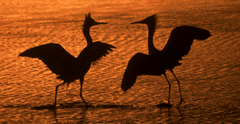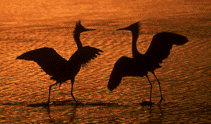While a camera is just a light-tight box that allows light to strike the
film, Canon's new EOS 1v is the finest camera that I've ever owned. By far. It
is a Mercedes Benz to the EOS 3's soapbox derby racer. From the instant that you
pick it up, you are impressed with it's feel, it's heft, and it's sturdy
construction. And the first time that you close the camera back, or depress the
shutter button, you will be reminded of the first time that you shut the door of
a true luxury car. The 1v is a rugged yet finely manufactured precision
instrument and is far quieter than the EOS 3. And far faster.
With a continuous shooting speed of 10 fps in One-Shot AF, Manual Focus, or
with Custom Function 4-1 or 4-3 activated (and your thumb off the * button), it
is the fastest SLR in it's class (when using the Power Booster BP-E2 and the
rechargeable battery pack--which I highly recommend, otherwise you have the
Mercedes without the engine......). Fortunately, EOS 3 owners can simply remove
the Power Booster from their 3 and use it with the 1v. The quoted "9 fps in AI
Servo AF" is achievable only in ideal shooting situations. Canon technical
expert Chuck Westfall suggests 9 fps when photographing : "...a Formula 1 race
car filling the frame, a baseball player stealing 3rd base, or a group of
thoroughbreds racing at the Kentucky Derby." He adds, "In all of these
situations, lighting is likely to be good, subject contrast is likely to be
easily readable, and subject movement in terms of direction and speed is also
likely to be readable." For birds in flight on sunny days, I would estimate
about 4-5 fps in AI Servo AF, which is plenty fast enough for me. The shutter
button is responsive; I do not find myself ripping off five or six frames in a
row unless I choose to put the pedal to the metal. I rarely make more than one
image when I want to make only one.
Having put more than 50 rolls of film through my new camera in just 10 days
and seen the results, I am even more thrilled with my 1v than I was the day that
I took it out of the box and started playing with it. The Evaluative Metering is
similar to that of the EOS 3, but seems to be improved in some situations. For
example, when shooting a half frame Burrowing Owl against a light gray sunlit
background (the street), it was not necessary to add 1/3 stop of light as was
necessary with all previous EOS bodies that I have used. I am sure that as time
goes by, I will learn a few more new things about the 1v's Evaluative Metering
system. (Just for the record books, the 1v's evaluative meter does not properly
expose for a white sky on a cloudy day (without adding light) as the Nikon F-5,
with its superlative RGB color matrix metering does.) I was pleased to note--in
light of the initial embarrassing problems with the meters in the EOS 3s-- that
the meters on both of my 1vs agreed, and that the middle-toned exposures were
right on. I will soon be adding a third EOS 1v as a back-up.
At the St. Augustine Alligator Farm, I had the opportunity to photograph both
Great Egrets and Wood Storks in flight, often with the birds flying towards my
position. As with the EOS 3, the speed of initial focus acquisition was
incredibly fast, but in contrast with the 3, all of the images in each series
were sharply focused on the bird's eye...... (In all cases I was using the
central sensor only.) As soon as I saw those razor sharp flight shots, I ordered
the second 1v to use with the handholdable auxiliary lens that I carry into the
field most days in addition to my tripod-mounted 600mm IS. With a camera strap
on the 1v, I mount one of the following lenses on the second camera body: the
100-400 IS zoom, the 300mm f/4 IS--a great close-focusing telephoto, or the toy
lens, my beloved 400mm f/5.6L--still the world's premier lens for photographing
birds in flight . The rig is then simply slipped over my right shoulder where it
remains until needed to photograph birds in flight or in action, or, in
addition--with the 1-4 IS zoom, until I spot a nice scenic, bird- scape, or grab
shot. Other improvements (from the EOS 3) include a 100% viewfinder with
adjustable diopter, a viewfinder shutter, 1/250 second flash sync speed, and a
battery charge symbol on the LCD.
The EOS 1v offers 20 Custom Functions with a total of 63 different settings.
I use the following Custom Function settings: CF-3-1 (cancels DX coding), CF-8-1
(frame counter counts down), CF-9-1 (AEB is not canceled when you change film),
CF-10-3 (sets bright flashing of focusing sensor), CF-13-2 (Limits selectable
focusing points to 11 and links spot metering to central sensor), CF-14-1
(cancels automatic flash reduction, i.e., programmed fill flash), CF-15-1 (sets
second curtain flash sync), CF-16-1 (safety shift--in Av or Tv modes, shifts
shutter speed or aperture to obtain a suitable exposure), and CF-18-1 (allows me
to return to the central focusing sensor by pushing only the assist button). As
previously described in an article in the BT Journal, I continue to use CF-4-3
with the 1v and my 600mm IS lens (except in flight-shooting- only situations).
While I normally set CF-13-2 to reduce the number of selectable focusing
sensors from 45 to 11 (to make it easier and faster to move the focusing spots
around), there are times when I toggle back to the default setting (CF-13-0) so
that I can select any one of the 45 sensors manually. I do this when working
with a bird that is pretty much staying in the same spot and in the same
position so that I can select the sensor that falls directly on the bird's eye
and maintain sharp focus. (When I do this, I'll also switch back to CF-4-0 so
that the shutter button controls AF.) Having 45 selectable points may be a
wonderfully attractive feature for many nature photographers.
The EOS 1v will surely prove to be extremely durable, but I will spare you
all the metallurgical details. With 72 different parts either gasketed or
weather-proofed, and O-ring seals surrounding the lens mount and back cover, the
1v is extremely weather-proof as well. As I have never had a problem with the
EOS 1n or the EOS 3s when I've used them in the pouring rain or in very dry,
dusty conditions, this would seem to be no big deal. I have, however, noted
something wonderful. In the past, out of a fifty roll processing order, I'd
usually find two to five rolls with straight line scratches on the film. Most of
the scratches would be either at the front or the back of a roll, when the
pressure from loading or rewinding the film was greatest. This in spite of
trying meticulously to keep the inside of the camera free of dust and grit.
Sometimes, however, every slide in a roll would be scratched. "Grit on the film,
dirt inside the camera" the folks at Chelsea Lab in NYC always maintained. Guess
what? Fifty rolls with the 1v and not a single slide exhibited a straight line
scratch. Just maybe they are onto something with those O- rings......
In several months, the new EOS Link Software will (with Windows 98 PCs only)
provide users with the ability to choose form 30 distinct Personal Functions
and, in addition, with Exposure Data Management (a feature that yours truly will
never, ever utilize). The latter feature, which will prove invaluable to many
users ranging from beginners to some top professionals, will allow photographers
to capture and download a broad range of data about each image.
I, however, cannot wait until the software link is available so that I can
set PF-7, which enables continuous firing in AEB, and PF-8, which allow for 2
frame AEB), two features that I have been lobbying for for years. In addition, I
look forward to setting PF-22 which disables the shutter release when film has
not been loaded and prevents dummies like me from taking pictures without film
in the camera..... Of additional interest may be the PFs that set trap focus
(PF-16), allow the user to adjust focus tracking sensitivity (PF-12), and
shorten shutter release time lag in comparison to the standard setting (PF-26).
The negatives? Automatic Focusing Point Selection, though seemingly somewhat
improved from the EOS 3, continues to disappoint at times. Even when the subject
is completely unobstructed by grasses or other vegetation, AFPS loses focus too
often for my taste, even when the subject is clearly well within the focusing
ellipse (with all 45 focusing sensors activated). AFPS is best used by bird
photographers when making head and neck or vertical portraits of tall or
long-necked birds. In these instances, AFPS performs superbly and allows the
subject to be placed virtually anywhere in the frame. After I had my hands on
the EOS 3 for five minutes, I suggested that users should be able to select any
row or any column of sensors, and feel that the same would be true for the 1v.
(I have not yet tested AFPS for photographing birds in flight.)
For years I have begged Canon to place plus and minus symbols at the top and
bottom (respectively) of the viewfinder exposure scale so that photographers
would not and could not become confused when working in vertical format. This
inexpensive suggestion, which would cost about 3 yen, has not been incorporated
in the 1v. I have also pleaded for the Canon engineers to allow us to bracket
the ambient exposure when using fill flash (as F-5 users can do). This still
cannot be done with the dedicated flash units. Lastly, I have asked repeatedly
that the Custom Function button be made larger and not be recessed (as the
button is behind the palm door and cannot be hit accidentally). As is, the
button is nearly impossible to operate with gloves on. Maybe in the next
generation Canon pro body......
All things considered, the EOS 1v is by far the finest camera body that ever
produced by Canon; using one is an absolute pleasure. I look forward to getting
the Link Software ASAP and to using my Canon EOS 1vs to continue to make
wonderful images of free and wild birds for many years to come. (A bit of
advice: sell all of your EOS 3s now before the price for used 3s sinks even
lower!)


